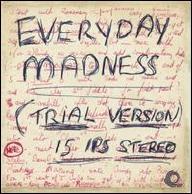In mid-1954 Ivor Kirchin was critically injured in an auto accident, and Basil attempted to lead the band on his own -- without a head for business, however, he struggled to keep the operation afloat before ultimately dissolving the lineup. Once Ivor recovered he returned to work, and with the formation of the New Kirchin Band -- a unit featuring four trumpeters, four saxophonists and three percussionists -- their sound veered away from traditional big band jazz to a more rhythmic, brassy approach that proved extremely popular with listeners, and after just ten months in existence, they placed fourth in a -Melody Maker reader poll of Britain's most popular groups. After recording four singles and an EP for Decca, the Kirchin Band signed to Parlophone, where they collaborated with future Beatles' producer George Martin -- moreover, they were the first band to travel with their own P.A. system, and Basil obsessively recorded each live performance and rehearsal session, including now-legendary dates backing Billy Eckstine and Sarah Vaughan. However, he felt increasingly confined by the limitations of the big band model, and at the peak of the Kirchin Band's fame, announced its dissolution in 1957, spending the next few years traveling the globe, including extended stays in India and the U.S.
After arriving in Sydney for what would amount to a two-year stay in Australia, Kirchin left his luggage -- including nine hand-compiled 7" tapes containing only the absolute highlights of the Kirchin Band's five-year run -- aboard his ship. Days later he received an apologetic phone call from the docks: In the process of removing the cargo from the ship, his luggage fell into the sea, and everything was destroyed -- in effect, his life's work was lost, with only their studio sessions to document the group's music. Although Kirchin finally returned to Britain in the spring of 1961, he abandoned traditional jazz forever, instead working with engineer Keith Herd on a series of electronic compositions written for imaginary films -- from there, he was commissioned to score a number of actual films, television programs, documentaries, and theatrical productions. In 1964, Kirchin began pursuing an approach he dubbed World Within Worlds -- essentially, he began combining traditional instruments with wildlife sounds and the amplified noise of insects, painstakingly editing and manipulating the results to create beautiful yet utterly alien soundscapes that clearly anticipated the subsequent ambient experiments of Brian Eno, as well as a generation of electronic artists like Aphex Twin. Not until the Swiss tape recording manufacturing firm Nagra issued their next-generation tape machines and microphones in 1967 was Kirchin able to acquire the technology necessary to fully realize his vision -- his source material grew more and more obscure, and his tape manipulations grew more and more extreme with each new project, discovering new "inner sounds" virtually inaudible at standard playback speeds.
While earning an income from soundtrack projects including 1967's The Shuttered Room, 1968's The Strange Affair, and 1971's The Abominable Dr. Phibes, Kirchin continued honing the World Within Worlds' aesthetic, finally releasing an LP under that name in 1971 -- a sequel followed two years later, this time featuring liner notes written by the aforementioned Eno. However, record company meddling and politics victimized both records, and a disillusioned Kirchin accepted more film and TV work in order to continue funding the equipment needed to further his more personal projects. Sadly, no new material was forthcoming for decades, and only in 2003 was Quantum -- a work fusing live performances from Evan Parker, Darryl Runswick, Kenny Wheeler, and Graham Lyons with ambient field recordings and the voices of autistic children -- finally issued on the Trunk label. The two-fer Charcoal Sketches/States of Mind -- the latter composed in 1968 for a psychiatric conference -- soon followed. ~ Jason Ankeny, Rovi


















